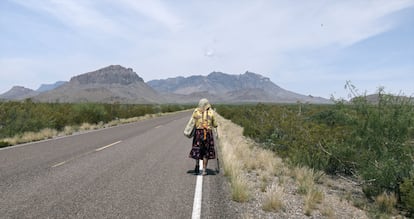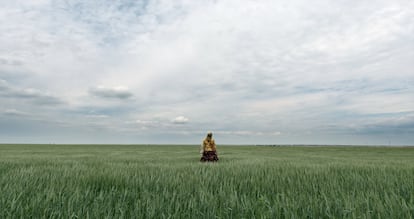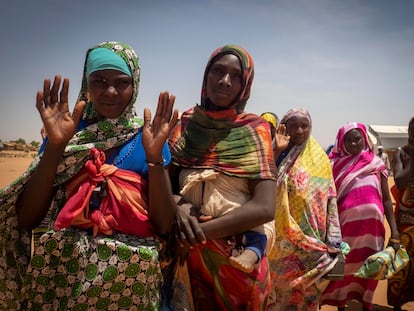The day Rita became a star: a Tarahumara woman who spent 12 years in a Kansas psychiatric hospital
Documentary ‘The Woman of Stars and Mountains’, largely narrated in the language of the Rarámuri, revisits an Indigenous woman’s case of negligence and injustice, which was marked by racism and violence


Rita Patiño was a Rarámuri runner who loved to dance, sing, eat and attend parties. She possessed knowledge of herbal medicine and had worked as a midwife. One of her walks led her so far from her people that, without realizing it, she left her home state of Chihuahua. A Tarahumara, she was able to easily cross dozens of rivers, fields, canyons and mountains on foot. One night in 1983, Kansas police, in the heart of the United States, found Patiño in a church, tired and afraid, more than 1,242 miles from her home in the Urique Canyon. Without access to an interpreter, she was sent to a psychiatric hospital and improperly diagnosed as schizophrenic.
Patiño was deprived of her liberty and stripped of her rights for 12 years, until, thanks to a legal team who provided assistance, she was able to return to the Sierra Tarahumara in 1996. She lived out her final years with serious side effects cause by wrongfully prescribed medications. With very few resources and amid complex familial and social conditions, her niece Juana Osorio — known as Juanita — cared for Patiño until the elder’s death in 2018, at which point she became a star. In the Tarahumara belief system, the people came from stars and upon their earthly death, transform back into the heavenly bodies.
How did Rita get to Kansas? How did she cross the border and navigate so much land to arrive there? Why did no one make an effort to understand anything but her anger? Mukí sopalírili aligué gawíchi nirúgame or, translated from the Rarámuri language, The Woman of Stars and Mountains, is a documentary by Mexican filmmaker Santiago Esteinou that revisits this case of negligence and injustice, which is marked by racism and violence against a person who was unable to communicate with her captors. The film retakes the life of a woman who no one, throughout those 12 years, truly made an effort to understand.

The Rarámuri people live in northern Mexico, and their name means foot runners, composed of the roots rara (foot) and muri (run). Esteinou, who began to work on the project in 2016, came to Rita’s story through a book that he was lent, Born to Run by Christopher McDougal, which is about a runner who moved to the Sierra Tarahumara. On one of its pages, it mentions a Tarahumara runner who became displaced from Chihuahua. When she was found, hospital staff believed that her vocalizations were “illogical babbling”. In reality, she was speaking in Rarómuri, a variation of the Rarámuri tongue. Esteinou found the runner’s family and got in contact with them. Her story wound up becoming the subject of his documentary.
“What interested us was going beyond the hospital incident to understand who Rita was, to understand her as a woman, as a human. Initially, we had planned to make an observational documentary that would tell her story, but above all, be a follow-up on what was happening in the present with her life and the life of her niece. We couldn’t make that happen because in the initial stages of filming, Rita died,” says the filmmaker.
Esteinou and his production team were able to spend time with Rita and film her intermittently throughout 2016 to 2018, during which time, according to the director, they began establishing “a good relationship” based in trust. Still, they had made a commitment to make the film, and needed to finish it, which raised the question of how to finish a movie when its protagonist has died.
The answer for The Woman of Stars and Mountains meant also including the voices of people who were tied to Rita’s defense in the United States, individuals who were well-known in the community and, of course, the relationship, affection and care that her niece, Juanita, dedicated to Rita upon her return to Chihuahua. Mixtec director Ángeles Cruz, who is from Oaxaca, also joined the project, bringing her experience as actress and her knowledge behind the camera to give shape to one of the documentary’s other pillars, which was the recreation of the path Rita took to get from Mexico to the United States.
“We created all the images that were a little bit more evocative, to a certain degree, fictionalized. What we were trying to do was create the path that Rita could have taken from her home towards Kansas. We were making that trip by car and kind of evoking things that, being there, we imagined that she could have experienced. In that sense, working with Ángeles was very enriching, because she is an incredible person and also very talented,” says Esteinou.

The recovery and presentation of Patiño’s language was important to the team, but also the inclusion of all the connotations it brings, from the Rarámuri worldview to ancestral, social and cultural aspects. At the beginning of the process, they worked with Erique Servín, a Chihuahuense writer and noted defender and scholar of Indigenous languages, who was found dead from a blow to the head in 2019 and whose murder remains unsolved. The death of the activist unmoored the production crew, who struggled to make sense of many of the story’s elements. It was then that they came into contact with Adrián Moreno, head of the Ethnic Cultures and Diversity Department at the Chihuahua State Secretary of Culture, who became interested in the project because of its intent to “visibilize and strengthen awareness of Indigenous communities,” he says.
“It [the documentary] interrogates the importance of language in these situations, especially here, with respect to access to justice and health,” says Moreno. It was important to him that the film had chosen narration in Rarómuri, to seek to understand another way of existing in the world, “of interpreting and understanding reality.”
“Rita’s situation could be one that drew a lot of attention and that was high-profile in its moment, but hers is a situation experienced by the vast majority of people who speak an Indigenous language. Many times their reality is folklorized, saying ‘how beautifully they dance’, ‘how beautiful the language sounds’, but from afar. We must create better context of use and support that as much as possible. There should be more productions with this kind of subject matter, that speak in Indigenous languages not just from Chihuahua, but the entire country,” concludes Moreno.
Sign up for our weekly newsletter to get more English-language news coverage from EL PAÍS USA Edition
Tu suscripción se está usando en otro dispositivo
¿Quieres añadir otro usuario a tu suscripción?
Si continúas leyendo en este dispositivo, no se podrá leer en el otro.
FlechaTu suscripción se está usando en otro dispositivo y solo puedes acceder a EL PAÍS desde un dispositivo a la vez.
Si quieres compartir tu cuenta, cambia tu suscripción a la modalidad Premium, así podrás añadir otro usuario. Cada uno accederá con su propia cuenta de email, lo que os permitirá personalizar vuestra experiencia en EL PAÍS.
¿Tienes una suscripción de empresa? Accede aquí para contratar más cuentas.
En el caso de no saber quién está usando tu cuenta, te recomendamos cambiar tu contraseña aquí.
Si decides continuar compartiendo tu cuenta, este mensaje se mostrará en tu dispositivo y en el de la otra persona que está usando tu cuenta de forma indefinida, afectando a tu experiencia de lectura. Puedes consultar aquí los términos y condiciones de la suscripción digital.
More information
Archived In
Últimas noticias
A hybrid building: Soccer pitch, housing, and a shopping mall
Europe urges Trump to respect Greenland following annexation threats
Science seeks keys to human longevity in the genetic mixing of Brazilian supercentenarians
Luisa Neubauer, climate change activist: ‘Ecology shouldn’t be a punitive force, but a joyful and liberating one’
Most viewed
- Alain Aspect, Nobel laureate in physics: ‘Einstein was so smart that he would have had to recognize quantum entanglement’
- Alvin Hellerstein, a 92-year-old judge appointed by Bill Clinton, to preside over Maduro’s trial in New York
- Cuba confirms death of 32 of its citizens in the US attack against Venezuela
- Gilles Lipovetsky: ‘If you want to live better and fall in love, take Prozac, don’t look to philosophy’
- Why oil has been at the center of Venezuela-US conflicts for decades










































